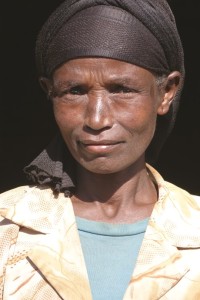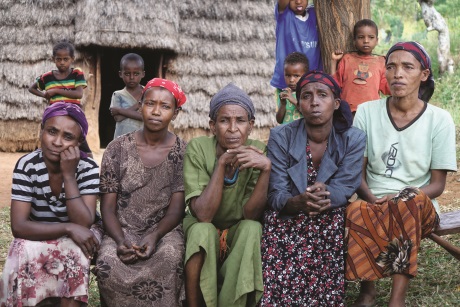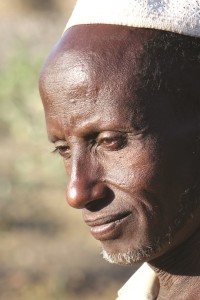I first saw Mogite Moja across the courtyard. There was controlled chaos as there always is during these visits. We had walked a few hundred metres surrounded by excited children, jumping, laughing along, and through subsistence farms to the village. There was a scurry to accommodate us. Chairs and benches were found and set in a semi – circle, the children calmed and moved to the edges.
I stood under a tree and watched the proceedings take shape. We were the biggest thing to happen to this little village in a long time. One of my fellow travellers was surrounded by a dozen kids; he was taking their pictures and then showing them the image on the back of the digital camera. This thrilled the kids, their responses turning from shock to recognition each time, seeing themselves on a small screen.
I saw Moja about 20 metres to my left. She was standing still; a quiet, strong presence in the midst of animated madness. I took her picture; and again as her eyes shifted slightly to see the camera pointed at her. I had been in Ethiopia less than two days. Looking at her through the lens, the way she absorbed all the information around her, the strangers, the children, with confident grace, I hoped this was the story of Ethiopia I would be telling. Seconds later she joined the fray, helping with the seating arrangements, and getting our meeting started.
A country known to most Westerners for civil wars and famines is bursting in every direction. Ethiopia itself seems to be in the midst of a boom, with an economy growing at 10 per cent per annum. Thousands of kilometres of new roads are being paved across the country. A new highway connects the landlocked country to the Indian Ocean via Djibouti. That particular road is busy, crammed with trucks importing and exporting products all day and night.
A new half billion – dollar rail – transit system will open this year in the capital, Addis Ababa. Large swaths of land have been annexed. Ancient alleys and roads stuffed with low – rise homes and businesses razed to build the future. Elsewhere across the city are endless walls of tens of thousands of new condominiums. Various funding schemes—10 per cent down, 90 per cent low rate mortgage; to 40/60 loans—have been introduced. These funding schemes are dependent on having bank accounts and savings.
Nearly three billion dollars of exports leave Ethiopia annually. That number has been rising over the recent years. Coffee is good for almost 30 per cent. A half of all exports are also agriculture related—oily seeds, legumes, bovines, leather.
Still, more than $11 billion is imported; from petroleum to wheat to rubber boots. The imbalance is massive and growth needs to continue to bridge the gap. Lots of growth; new ideas and industries are being introduced regularly. A honey factory is being built in the tourist city of Lalibela. Cut flower farms—hectares of greenhouses—were introduced within the last decade or so and are now almost eight per cent of the country’s export, making Ethiopia the fourth largest flower power in the world. Ethiopian roses may well be sitting in a vase in your home right now.
China is the country’s primary trade partner, for both imports and exports. China is also a major investor, funding, among other things, the transit system in the capital city and the major roadwork across the country. And they have a piece of the honey factory.
Seen steadily along the import – export highway are the carcasses of crashed trucks, sometimes taking other vehicles and animals with them. Too much speed, too much pressure to grow. Ethiopia, like so many other developing nations, has finally found the formula: Foreign investment and ownership, local labour and international exports—and a government that is willing to accept it.
Welcome to the new Ethiopia.
I am in Ethiopia as a guest of Canadian Foodgrains Bank, along with four others representing some of the bank’s 15 denominational partners. CFGB has been providing relief and development work in Ethiopia for 30 years, starting during the famous famine that was inspiration for international fundraising efforts which included Christmas pop songs and rock concerts.
Recipient at the last General Assembly of the E.H. Johnson award for cutting edge mission, CFGB started as a Mennonite effort in the mid – 70s to allow farmers to donate their grains to those without around the world. In 1983, the grain bank was opened to other denominations.
Just as the partnership was instituted, Ethiopia hit the front pages of papers around the world for what a BBC reporter famously described as “the closest thing to hell on earth.” For many of us, images of that famine are seared into our brains; starving children with distended bellies, the arid landscape. The international response was massive, with millions of dollars of relief flowing to Ethiopia.
CFGB was immediately involved in bringing relief. The stories of those efforts are legion—how grains were gathered in Canada, shipped along the St. Lawrence and across the Atlantic to the African coast where they were bussed across the massive continent to the region in northeastern Ethiopia most affected.
Though Ethiopia was once considered the breadbasket of Africa, it has a long history of droughts and famines. Tens of thousands had died in one in the Afar region in the early ‘70s. That famine was the downfall of Emperor Haile Selassie, the father of modern Ethiopia who had ruled for four decades. His deemed indifference towards his people during the drought brought on a famine. He was overthrown. His leaving encouraged rebellions and insurgencies along ethnic, cultural and political lines, for the next decade at least.
Just as the rains stopped in the early ‘80s, the government announced it would be spending half its money on the armed forces fighting various fronts. Lack of resources and support left millions to fend for themselves in a wasteland, leaving hundreds of thousands dead and displacing large populations. A distracted government and deep layers of corruption kept a lot of the international aid that was promised from reaching the intended recipients.
The fact that organizations like Canadian Food – grains Bank were able to get food into the hands of the suffering are that much more heroic when placed in the context of the different layers of tensions that was Ethiopia in the ‘80s. The Presbyterian Church in Canada was a partner and had personnel in Africa monitoring the deliveries.
From that hell of three decades ago, through many political machinations and foreign investment, a new modern Ethiopian economy has been growing at 10 per cent per year over the past decade. And it is heading towards meeting all of the Millennium Development Goals; lowering infant mortality rates and general poverty rates across the country.
Little of this is solace to Mogite Moja.

She is one of the poorest people on the planet; living as she does in one of the poorest countries in the world, which Ethiopia still is despite the economic headlines. Our tour is causing a commotion in her village on a November morning because Moja is a member along with a dozen other women of a self – help program that started in 2007. The concept was introduced to them by a local organization, Wolaita Kale Heywot Church Terepeza Development Association, which is supported by World Relief Canada, of the Evangelical Fellowship, which is a CFGB partner.
(An aside: If you were to give one dollar to Presbyterian World Service and Development, and that dollar is forwarded to CFGB for international relief or development work, it could be matched $1 – $4 dependent on the project, through our federal government’s Department of Foreign Affairs, Trade and Development. And, given the intricate web of partnerships our church has through other denominations and their local partners (and they through our local partners), your one dollar can go to almost any remote corner of the planet very quickly with up to quadruple its power. This network of care is one of the most profound systems at work in our world today.)
Moja and the local village women formed a cooperative they call the Village Flower. They made a commitment to meet weekly to save money collectively. At their first meeting each of them brought in half a Birr (Ethiopian currency), or about two Canadian pennies. They added to that sum regularly; each with their tuppence.
They were trained how to hold a meeting. How to make decisions. Their only male member was the secretary/treasurer who could read and write and could keep minutes and the accounts. Along the way the women made small loans to each other. Moja, for example, borrowed money to buy school supplies for her children, so they could get an education. (Schools in the developing world aren’t heavily subsidized like ours; children are expected to bring their own supplies. No supplies, no school.) The group is saving to buy a grinding mill—so they can process the maize their husbands grow, and rent the machine to others.
The Village Flower has 6,000 Birr, or about $300, in the bank today. They started with a quarter.
That is a remarkable story: A little training up front, continuous guidance, an incredible amount of commitment and focus by the group, and small, continuous victories. Some women borrowed money to buy seeds, to grow an extra patch of fruits, vegetables, grains, to sell at the weekly market. They pay interest on the loan, and share their profits with the group.
Inspired by the Village Flower, women in a nearby village approached Terepeza to start their own group. And so it grows.
But, we weren’t in that village in the Sodo district to meet the women’s group only. We were there to look at soil. Eighty per cent of Ethiopia’s nearly 100 million people live by the land. (Ethiopia is the world’s 13th most populous country; and according to the Multidimensional Poverty Index, a way of looking at national wealth that factors more than just economic markers, the world’s second poorest.) The earth determines how they live. The sun is steady, rains go through their cycles. The state of the soil is everything.

We travelled 2,000 kilometres around Ethiopia looking at soil. In Sodo, south of Addis Ababa, we witnessed conservation agriculture, which basically means no tilling of the soil. Tilling evaporates the moisture in the ground. Instead of turning the soil and spreading seeds, the farmer covers the farmland in mulch and has to place each seed individually. It is labour intensive. The farmers we met had been experimenting on small portions of their land. They complained about having to dig each seed through the mulch, but boasted of yields sometimes six times what the rest of their land was producing.
In the eastern district of Boricha, we saw a miracle. Years of droughts and political insensitivities and famines had left a whole region stripped of all vegetation. As we approached the project area we passed through vast barren areas. Complete hillsides yellow with parched earth. There was nothing to hold it. Sam Vander Ende, CFGB’s man in Ethiopia, said, “The topsoil of Ethiopia was washing out to the Mediterranean Sea.”
But in the project area, suddenly vegetation. It was a miracle 10 years in the making. Trenches were cut in the side of the hills to slow the rains, to catch the water. Small bushes were planted. More holes dug. To reverse the erosion you have to hold the water in place. With a little bit of water you can plant trees. They hold more water. It takes time. The soil has to be loved back to life.
As the soil revived, the villagers returned from their desperate wanderings. With them cattle and children, and once – dead, parched acreages became alive again. Life out of a dead thing. A miracle.
Sure, a lot of hard work. Labour intensive for years and years. Funded through CFGB by the Mennonite Central Committee and managed by an Ethiopian partner. Food and Cash for Work schemes to bring ditch diggers. An $800,000 budget just for last year to affect the lives of over 70,000 people. A hard earned miracle.
We drove for two long days, through the Rift Valley, to the Afar district in the north. Here another miracle too fantastical to imagine.
It starts with Gebreyes Haile, who was the local director for Canadian Lutheran World Relief for many years. In pondering the plight of the pastoralists (nomadic) people in the Afar—who for generations have been following their cattle across vast landscapes which are inhospitable to vegetation—he struck on the idea of redirecting canals from the Aura River to irrigate the land.
Think of the challenge from this simple idea: build small dams along the river, build canals from the river to designated areas which would then become farms, teach pastoralists to farm converting them to agriculturalists.

A dozen years since the project started, Mohammed, one of the beneficiaries, told our group: “Before this we used to move to water and pasture. We ate wild fruits. To eat we had to walk, sometimes it would take two weeks to walk on foot to get food. We had to buy food from the highlanders (where there is more rain). We used to be no better than our animals. We thought of ourselves as animals. Now we are human beings.”
Sam Vander Ende has been with CFGB in Ethiopia for 22 years, starting as a food aid monitor in southern Africa. He’s been here since. His wife, Kathy Marshall has a textile business, which is introducing silk along with the established cotton industry. Their two daughters were born in Ethiopia. He still travels back to Canada regularly but his home and his heart are in his adopted land. (You can see a feature interview with him below.)
He has the passion of a convert. He speaks of Ethiopia with personal pronouns. He introduces me to a phrase I’ve never heard before, “Green Famine.”
“In an abstract sense, the soil is the only thing that we have. That’s the medium. What is progressively happening over time is that the medium is being destroyed. Its ability to generate growth, that production that we need to sustain ourselves, is becoming diminished. It’s a function of extraordinary growth of the population. In turn, they are stripping the land. They’re cutting down the trees, cutting down the plant life at a rate that the land can’t regenerate itself anymore through natural forces. And so with the passage of time the land is being denuded, eroded because it’s a very mountainous place and the production goes down. And we suddenly find ourselves in a green famine. Everything around us is green, yet people are in famine – like conditions.”
A host of circumstances, mismanagement, bad luck and indifferent government policies abet the famine, robbing the poor of the soil that nourishes them. The economic booms and the monster horrors keep the focus away from the daily lives of those struggling to save two pennies a week.
It takes vigilance, funding and a few simple ideas—redirect a river, don’t till fragile soil, collect pennies, dig holes in a mountain to slow water—to keep the Mogite Mojas and the Mohammeds alive and flourishing. Our denomination has a part through CFGB keeping hope alive and children fed in a little landlocked country.
In the end Moja was the story of Ethiopia I had hoped for, an indomitable presence within a chaotic flurry. Her world is constantly fragile, caught between economic booms and the lush green pastures of the Ethiopian highlands and the constant threat of droughts and famines of the lowlands. She lives there in the thin space between ‘Green’ and ‘Famine’ and we are there with her because we can be and because we are compelled to be in the name of the One who walks with us. And with her.
Find more of Andrew’s Ethiopia photos on our Flickr page: flickr.com/photos/presbyterianrecord.

